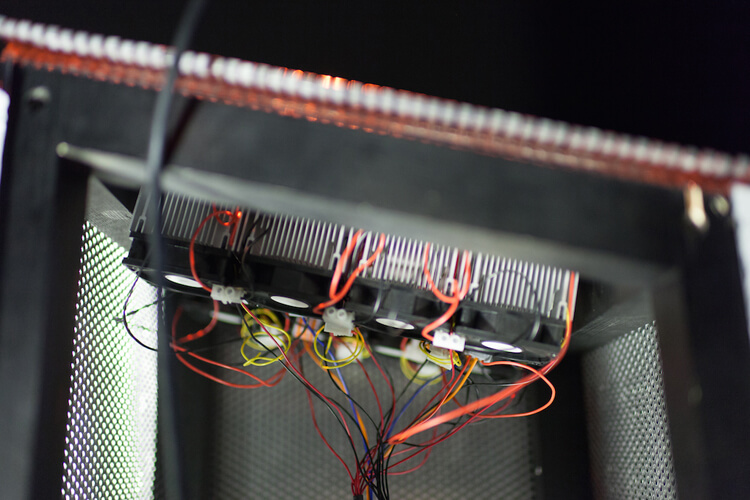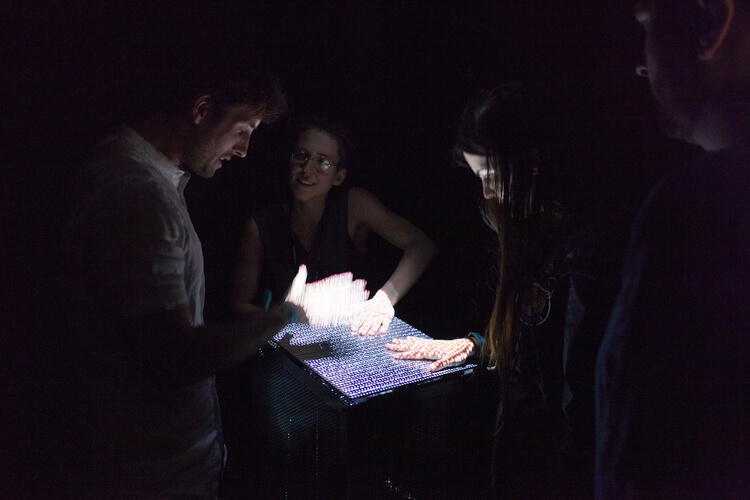Interview by Sebastian Kamau

How are our senses linked to reality? Can we trust our senses? How does our brain parse out contradictory sensory information? Exploring these questions lead Swedish physician Torsten Thunberg at the end of the 19th century to develop the thermal grill illusion. The illusion uses a grill with alternating moderately warm and cold rods to provide a burning sensation.
While the warm or cold rods can be individually held comfortably, when held together, the sensation can be unbearable. The thermal grill illusion has been used to study how the brain registers sensory information and was the focus of the installation Absolute Relative at Sonar+D 2016.
The installation replicated the thermal grill illusion using a raised metallic panel that visitors are encouraged to gather around. Much like a dining table, where conversation flows naturally between both the food and diners’ experience of the meal, the installation facilitates conversation amongst visitors about the installation. Overhead, a camera outfitted with an infrared sensor captures a heat map of the visitors and the thermal grill.
The installation was created by Maria Euler, Luka Kille, Ava Watson, and Ker Siang Yeo, Master’s students in the Information Experience Design programme at the Royal College of Art, with sponsorship from the vodka company Absolut. With backgrounds ranging from aeronautical engineering to fine art, the team’s collaboration and work are as much a product of the interdisciplinary emphasis at RCA as it is informed by their own specialities. We’re looking forward to seeing how their work develops in the years to come.


Absolute Relative crafts stories about perceptions and transforms them into an interactive installation. For those that are not familiar with ‘Absolute Relative’, could you tell us who is behind it? What drew you to work at the intersection of science, technology and art?
The four of us got together to work on a proposal to be selected to exhibit in Sonar +D, Barcelona, Spain, with Absolut. We are undergoing a Master’s programme in “Information Experience Design” together at the Royal College of Art. Like many programmes at the RCA, we are encouraged to develop interdisciplinary thinking, in particular in the combination of art, science and design.
The urge to connect those fields was what brought us to the program initially. Our backgrounds are quite diverse; taken all together, we studied fine art, transmedia art, aerospace engineering, product design, culture studies/ social science and physics before we came to the RCA. We search for models and inspirations that can hold ideas and offer experiences while being approachable to people from different backgrounds.
Absolute Relative is an interactive installation that questions that our perception is never absolute. Could you tell us a little bit about the intellectual process behind it?
The call asked us to explore the term “black box”. A black box is a technology in which we know its function but not how it works. Yet, and this was the crucial point for us, it is a way to understand the brain. We are unaware of both its basic setup and the rules of our perception and thinking. Most of the time, we use our brains instead of exploring or questioning how it works. The same happens increasingly with our technologies as they grow more and more complex.
We learned about the “thermal grill illusion”. It was discovered by Torsten Thunberg (1873 – 1952), and you might actually run into it at a good science fair or museum. Areas of mildly warm and mildly cold temperatures are offered in close proximity to be touched together. Yet, when one touches the setup, the perception is of either extreme warmth or coldness. This is due to the working mechanism of our perceptive system. We only register “relative distances”.
This means we never feel cold or warm, just colder than or warmer than a reference. We felt the experiment itself needed to communicate its ideas beyond the boundaries of a science textbook, scientific footnote, or science museum. In our opinion, the experience of this effect can make you become aware of the process of your perception. It reveals how our perception is relative. Quite often, it still results in useful or practical judgements, but can also go wrong and be misleading. Every perception is immediately interpreted and put into context by our brain. We wanted to enable people to make the experience that leads to this understanding.
We also wanted to stress that this is a valuable model for considering moral or social thoughts and perceptions. When even our perception of temperature is relative and heavily dependent on context and the makeup of our brain, then our perception of social values has to be treated more carefully as well. This is where the role of artists and designers can flourish.
Working and straddling this intersection is a fertile space for knowledge and innovation to become curated experiences. By changing the presentation and context of the experiment, we encourage people to approach it. That way, they do so with a mindset and attitude that might differ from the one they would have at the science fair or museum.
This way, we seek to raise the probability that they connect the thought and experiences that can spark from this experience with different fields of their life. Raising awareness for our boundaries to prevent ignorance and enriching people’s lives with an experience that can provide them with new thoughts or serve as a manifestation of existing thoughts was, and is, our aim.
What was the biggest challenge you face in its development?
We had only two months to design, build, transport and install the piece. Of course, making the structure brought up technical design problems: we had to overcome the issue of balancing heating and cooling. The making fell at the time of the final shows at the Royal College of Art, meaning that all the workshops we have access to are not easily available.
The biggest adventure was certainly the transportation via aeroplane as our check-in and hand-carry luggage. Especially for the main console, we did not want to check it onto the flight for fear that it would not get damaged. Therefore we decided to transport it as hand-carry luggage. Yet, without the rest of the sculpture’s structural parts, all the wiring looks a little dangerous and suspicious.
Therefore, we had the Royal College of Art give us a certificate that basically stated that this was art and not a weapon. In the end, everything went very well, but our hearts were pounding very hard at every security check and with every bump in the road.
How people respond to multiple stimuli in a digital environment beyond the touch of a screen or button is one of the questions to answer in this 21st century in which people live in a hyper-connected society. In which ways do you think are interactive and digital technologies changing or affecting human behaviour?
Technology is usually painted in a sceptical and negative light, especially in journalistic media. Of course, technology can be dangerous if used in certain ways. Technology has made our lives better, and it is our behaviours in the first place that results in the emergence and design of technology. Books also offer stimuli from beyond the “real” or “physical” world. And they certainly changed society and every single reader. But, we do not perceive that chiefly as a technology.
They have an almost “natural” status. In the same way, modern technology will become “invisible” through the right authors mastering the medium through repeated usage. As a result, we will finally focus mainly on the content communicated via this technology in this specific instance rather than the technological means.
What we are trying to say with this: Of course, interactive and digital technology will change human behaviour, as the book did, but in the long-term, through the content, it enables us to communicate or share or offer to experience, not through its technicality. By being enabled by new technology to use more senses and to reach out further, the potential for communication is heightened. But the important point is how that potential is used.
Multisensory, interactivity and “hyperconnectivity” not for their own sake but to communicate something. As designers and artists, our role is not to make the technology obvious and scream to people about how ‘innovative’ we are with it. Our role is to make it almost disappear, such that we will not even know that it is there and that when we use technology, it just is. Human behaviour is influenced continuously. Like with books, first through an increased reach, but in the long run, through the content transported by the technology.
What is your chief enemy of creativity?
The notion that there is absolute knowledge. If you assume everything is already solved and available to you, you lose the urge to create. That is also horrible and dangerously wrong for our progress as human beings. Alas, it is paradoxically also a problem to try to present a ‘perfect’ solution. We should create the awareness that we are just proposing models and offers to think and experience through. You have to find a balance.
If you approach your work seriously, hoping to solve everything correctly, you are paralysed. Without leaving out something, you can not create. True creativity emerges when we handle constraints elegantly. If there are no constraints, there is no need for artists and designers. But being too lofty about everything is bad too. In that case, you lose the motivation together with the justification and relevance of your work.
The other problems are bureaucracy or real-life obligations, as they inevitably come up when dealing with a sponsor or client. But you can learn to deal with those or find help, and it actually makes us more aware of our role in society. It makes us grounded in parts and makes us realise that whatever we decide on should not be assumed to be amputated from society.
You couldn’t live without…
The materialisation of our thoughts from time to time. We are often working with very theory-heavy thoughts as we engage in a lot of research. That is good because it inspires and leads to new thoughts. But to stay sane, it is necessary to “materialise” some of those thoughts from time to time. To put them down in a touchable, approachable project.
This sets the brain “right” again. The thoughts stop spiralling like crazy and instead focus on a point. To share our work and see people interact with it and react to it is the other thing that is absolutely necessary to keep us going. When we see a spark of those thought complexes, or even new ones, in the eyes of somebody interacting with our work, we can feel really happy. As for the ‘Absolute Relative’ project in Sonar+D Barcelona specifically: Tapas and Haribo were also indispensable.






